Biking and skating can lead to falls. To keep it safe, the head needs protection, but are skateboard helmets and bike helmets the same?
The skate helmets vs. bike helmets decision should start with safety, but after that crucial choice the possibilities are still vast. Helmet functionality matters too.
It’s not simply because you would look silly that you don’t want to ride your town bike to the local coffee shop wearing your equestrian helmet. Of course, some differences come down to sport-specific style and features.
If you want to understand the differences between skate helmets and bike helmets, this article breaks it down for you.
Features | Bike Helmets | Skate Helmets |
|---|---|---|
Safety Standard | ||
Head Coverage | ||
Visor | Cell | |
Vents |
Safety Standards:
Different sports have different helmet safety standards. Some standards are government mandated, particularly for bicycle helmets, and some are just consensus rules that manufacturers ideally follow.
Stickers on the inside of helmets indicate conformity to safety standards. Below are some basic guidelines.
Bike Helmets:
Skate Helmets:
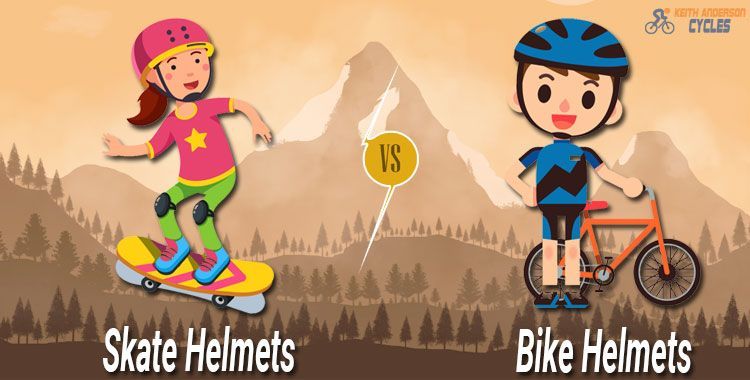
Skate Helmets with Better Protection
Don’t many skating activities—such as in-line skating, rolling-skating, riding a kick scooter, electric skateboarding, longboarding, and skateboarding—also put the user at risk of one high impact?
The answer is yes. As a result, most skate helmets today are dual-certified and conform to the CPSC standard.
Head Coverage:
The main visible differences among helmets are the vents, visors, and head coverage. Differences in coverage come from the types of falls and collisions associated with each activity.
Downhill mountain bike helmets and aggressive BMX helmets have full face coverage. Essentially, serious jumping or serious speed on a bike requires a serious helmet.
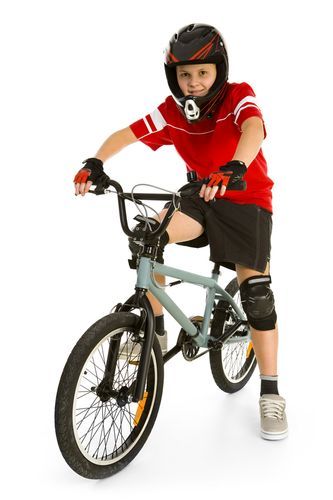
Full face bmx helmet
Although those who are safety conscious may jump to the conclusion that this greater protection is desirable for multiple uses.
Full face helmets aren’t recommended for general use because they are heavier, less comfortable, and hotter than other helmet types.
Road bike helmets do not cover the lower part of the back of the head. Road riders typically don’t fall off the back of the bike, which can lead to the back of the head hitting the ground.
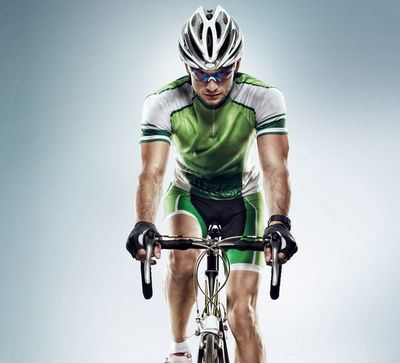
Helmet without back head
Many mountain bike specific helmets do have lower head coverage in the back due to mountain bikers diverse types of falls and impacts.
Skate helmets, similarly, will have coverage on the lower part of the back of the head because skaters do fall backwards.

Skate helmet with back of head
To Visor or Not to Visor?

Mountain bike helmet with visor
Mountain bike helmets have visors, whereas road bike helmets do not. The main reason for this difference is that road cyclists usually wear sunglasses to shield their eyes.
Mountain bikers, given that they are often riding in shade, tend to wear clear or low light lenses and, therefore, appreciate the sun shade when they need it.
Additionally, road cyclists ride with their heads lower, sometimes in the drops. This more aerodynamic position means visors can get in the way of seeing.
Most skate helmets do not have visors, though some manufacturers, such as Bern, build a small, irremovable visor into their helmets.
Vents Are Cool, Right?
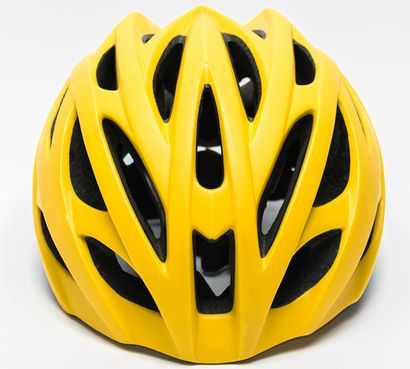
Road bike helmet with vent
Vents cool the head. Among various types of bike and skate helmets, road bike helmets have the most vents because users of the helmets heat up more.
Think of the commuter riding eight miles to work or the road rider out for a 30-mile loop. Even though these helmets have more holes in them, meaning less material, they tend to be more expensive.
Although this doesn’t seem to make sense, it’s due to the greater difficulty in constructing a safe, lightweight helmet with less material.
Pricier road bike helmets usually pay more attention to aerodynamics as well, and the more aerodynamic varieties have fewer vents, as the vents create wind drag.
The classic skate helmet design has a round, smooth shape with only a few vents. Generally speaking, less aggressive BMX bike helmets tend to stick to the style of skate helmets for vents and otherwise.
Style:
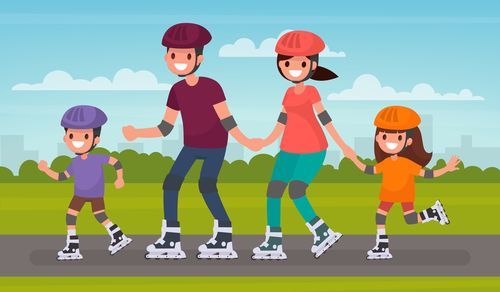
Some mountain bikers, commuters, and casual road cyclists prefer skate style helmets for the looks.
However, few skateboarders or skaters actively seek out bike style helmets for the looks. Arguably, skate helmets tend to be “cooler” and look more youthful.
Style-wise the skate inspired design is a better all-around choice as you won’t look out of place on a bike, skateboard, in-line skating, or even snowboarding (some manufacturers sell winter liners you can add to a summer helmet).
Therefore, people looking for versatility should not look to Tour de France riders for styling.
New Technology:
One new development for helmets is MIPS, which stands for multi-directional impact protection system. MIPS helmets are designed to reduce rotational forces in certain types of impacts.
MIPS adds to the cost of a helmet, but if it’s safer it’s probably worth it. Although they are widespread today, more research needs to be done before MIPS becomes a standard.
Final Thoughts:
This morning I saw two riders together, clearly not construction workers, both wearing bright orange cycling vests for safety—but without head protection!
That was a real head-scratcher. The unpleasant truth is that if you ride or skate you will likely do more than just scratch your head if you’re unprepared. You will crash. Some of those crashes may involve the head.
Therefore, it is best to protect the body’s greatest commodity, the brain. At the same time, helmets are a way to show your personal style.
The above skate helmets vs. bike helmets survey shows that there is substantial crossover among helmet types with functionality, style, and safety.
While style is obviously an individual choice, if you do show up to a new activity wearing a helmet because it’s the only one you have—in other words, not a style or safety choice—you’ll likely look like the newb you are.

Very helpful. Thanks!
Thanks, very helpful.
Fantastic article; very well written and helpful. Thanks!
Very helpful article. Thanks a lot for your information. Normally We never think of many pros and cons of a helmet, because we don’t know about it. When buying a helmet we fall so many problems that which one we choose. After reading such an awesome article I learn many tips and should apply when I need.
Thanks again.
Before choosing a helmet, we must consider these points! Thanks for sharing this beautiful piece with us. Safety First! Happy Skating!
This was incredibly informative! Thank you!!
Great share! Can’t wait to read more from you.
Wearing a bike or skate helmet incorrectly can prevent it from doing what it was designed to do. You need to make sure it fits your head perfectly. However, wearing it correctly means that it covers the majority of your forehead and rests a few inches above your eyebrows.
Moreover, wearing a properly-fitting helmet will ensure that it functions properly and effectively, keeping you safe on the road. Lastly, If a helmet does not fit properly it is of no use, even if it is a skate helmet or bike helmet.
Thank guys. This article helps me a lot.
Every skateboarder, pro or beginner, knows the need for safety in the sport. This aspect includes the proper execution of tricks and stunts and having protective measures such as wearing skateboard gear.
Keep your head safe with the best roller derby helmet. It may be any game in the world. Indoor or home games are rather safe because the tools and equipment are used to play the games are rather simple and harmless.
https://oursafetysecurity.com/best-roller-derby-helmet/
Wearing a helmet that fits properly will guarantee that it operates correctly and effectively, keeping you safe while driving. Last but not least, whether a helmet is for a bike or skateboard, it is useless if it does not fit properly.
Electric scooters are for everyone – and rightly so. The best scooter for heavy adults are a unit for everybody. As directed by the United Nations, when you buy a heavy scooter for yourself, you must know its advantages and disadvantages. It can use both small and large.
https://oursafetysecurity.com/best-scooter-for-heavy-adults/
There are many types of bike helmets and skate helmets available in the market, and confusion got me when I am not well informed about them. Thanks for sharing this information.
WoW! thats whats the actual difference. I have been operating a similar site but using the same helmet for skating.. lolz
While the content seems really good, the one actual photo of a skate helmet is a very poor choice. It is obviously too small for the child, so does not show what a skate helmet is supposed to look like on someone's head.
Another factor that should be discussed is that kids do not like to wear tight or confining things on their head, so tend to not wear helmets properly or at all when outside adult supervision. I live next to a park with a paved path for kids to ride bikes on. It is incredibly rare to see a kid with their bike helmet covering their forehead (even with parents in tow). They are usually tipped all the way back, with the front pointing up toward the sky. Worn like this, they provide almost no protection in an accident or fall. It is much easier to get them to wear a skate style helmet properly than a bike helmet. Also, it is often easier for parents to fit a skate style helmet than a bike style helmet on their kids.